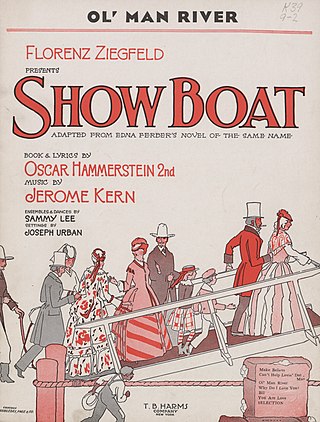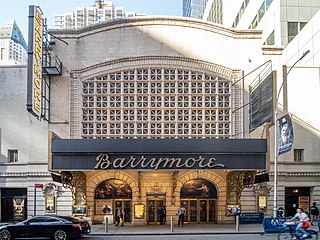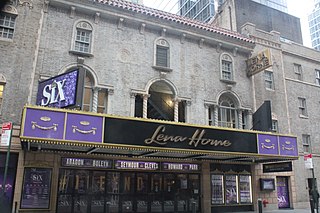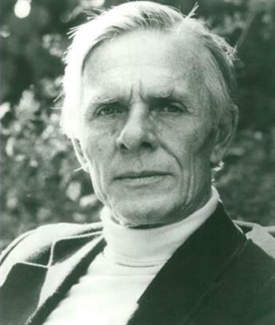
Joan Mary Waller Greenwood was an English actress. Her husky voice, coupled with her slow, precise elocution, was her trademark. She played Sibella in the 1949 film Kind Hearts and Coronets, and also appeared in The Man in the White Suit (1951), Young Wives' Tale (1951), The Importance of Being Earnest (1952), Stage Struck (1958), Tom Jones (1963) and Little Dorrit (1987).

Sir Peter Levin Shaffer was an English playwright, screenwriter, and novelist. He wrote numerous award-winning plays, of which several were adapted into films.

The Browning Version is a play by Terence Rattigan, seen by many as his best work, and first performed on 8 September 1948 at the Phoenix Theatre, London. It was originally one of two short plays, jointly titled "Playbill"; the companion piece being Harlequinade, which forms the second half of the evening. The Browning Version is set in a boys' public school and the Classics teacher in the play, Crocker-Harris, is believed to have been based on Rattigan's Classics tutor at Harrow School, J. W. Coke Norris (1874–1961).

Show Boat is a musical with music by Jerome Kern and book and lyrics by Oscar Hammerstein II. It is based on Edna Ferber's best-selling 1926 novel of the same name. The musical follows the lives of the performers, stagehands and dock workers on the Cotton Blossom, a Mississippi River show boat, over 40 years from 1887 to 1927. Its themes include racial prejudice and tragic, enduring love. The musical contributed such classic songs as "Ol' Man River", "Make Believe", and "Can't Help Lovin' Dat Man".

Peter MacNicol is an American actor. He received a Theatre World Award for his 1981 Broadway debut in the play Crimes of the Heart. His film roles include Galen in Dragonslayer (1981), Stingo in Sophie's Choice (1982), Janosz Poha in Ghostbusters II (1989), camp organizer Gary Granger in Addams Family Values (1993), and David Langley in Bean (1997).

Black Comedy is a one-act farce by Peter Shaffer, first performed in 1965. The premise of the piece is that light and dark are transposed, so that when the stage is lit the cast are supposed to be in darkness and only when the stage is dark are they supposed to be able to see each other and their surroundings. A young sculptor and his fiancée have borrowed some expensive antique furniture from a neighbour's flat without his permission to impress an elderly millionaire art collector. When the power fails, the neighbour returns early, other people also arrive unexpectedly, and matters descend into near-chaos.

The Neil Simon Theatre, originally the Alvin Theatre, is a Broadway theater at 250 West 52nd Street in the Theater District of Midtown Manhattan in New York City. Opened in 1927, the theater was designed by Herbert J. Krapp and was built for Alex A. Aarons and Vinton Freedley. The original name was an amalgamation of Aarons's and Freedley's first names; the theater was renamed for playwright Neil Simon in 1983. The Neil Simon has 1,467 seats across two levels and is operated by the Nederlander Organization. Both the facade and the auditorium interior are New York City landmarks.

The Bernard B. Jacobs Theatre is a Broadway theater at 242 West 45th Street in the Theater District of Midtown Manhattan in New York City. Opened in 1927, the theater was designed by Herbert J. Krapp in a Spanish style and was built for real-estate developer Irwin S. Chanin. It has 1,100 seats across two levels and is operated by The Shubert Organization. Both the facade and the auditorium interior are New York City landmarks.

The Ethel Barrymore Theatre is a Broadway theater at 241 West 47th Street in the Theater District of Midtown Manhattan in New York City. Opened in 1928, it was designed by Herbert J. Krapp in the Elizabethan, Mediterranean, and Adam styles for the Shubert family. The theater, named in honor of actress Ethel Barrymore, has 1,058 seats and is operated by the Shubert Organization. Both the facade and the auditorium interior are New York City landmarks.

The Gerald Schoenfeld Theatre, formerly the Plymouth Theatre, is a Broadway theater at 236 West 45th Street in the Theater District of Midtown Manhattan in New York City. Opened in 1917, the theater was designed by Herbert J. Krapp and was built for the Shubert brothers. The Schoenfeld Theatre is named for Gerald Schoenfeld, longtime president of the Shubert Organization, which operates the theater. It has 1,079 seats across two levels. Both the facade and the auditorium interior are New York City landmarks.

The Lena Horne Theatre is a Broadway theater at 256 West 47th Street in the Theater District of Midtown Manhattan in New York City. Opened in 1926, it was designed by Herbert J. Krapp in a Spanish Revival style and was constructed for Irwin Chanin. It has 1,069 seats across two levels and is operated by the Nederlander Organization. Both the facade and the auditorium interior are New York City landmarks.

The Broadhurst Theatre is a Broadway theater at 235 West 44th Street in the Theater District of Midtown Manhattan in New York City. Opened in 1917, the theater was designed by Herbert J. Krapp and was built for the Shubert brothers. The Broadhurst Theatre is named for British-American theatrical producer George Broadhurst, who leased the theater before its opening. It has 1,218 seats across two levels and is operated by The Shubert Organization. Both the facade and the auditorium interior are New York City landmarks.
Marilyn J. "Lynn" Farleigh is an English actress of stage and screen.

Frank Permain Vosper was an English actor who appeared in both stage and film roles and a dramatist, playwright and screenwriter.
Mia Dillon is an American actress.

Jane Baxter was a British actress. Her stage career spanned half a century, and she appeared in a number of films and in television.
Anthony Powell was an English costume designer for film and stage. He won three Academy Awards, for Travels with My Aunt (1972), Death on the Nile (1978) and Tess (1979).

Basil Henson was an English actor.

In Praise of Love, originally entitled After Lydia, is the first part of a 1973 double-bill play by the English playwright Terence Rattigan. It was the penultimate play he wrote.
Kind Sir is a 1953 play written by Norman Krasna and directed by Joshua Logan. It was the inspiration for the 1958 film Indiscreet.















